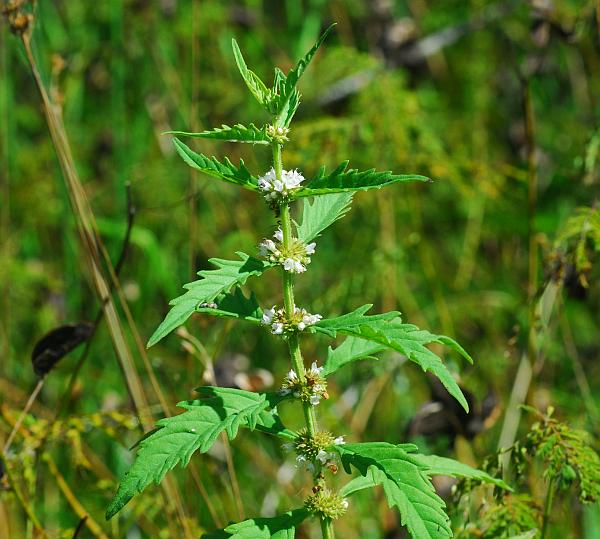Lycopus americanus Muhl. ex W.P.C. Barton
American Bugleweed

Native
CC = 4
CW = -5
MOC = 89
© SRTurner
Lycopus americanus Muhl. ex W.P.C. BartonAmerican Bugleweed | |
 |
Native CC = 4 CW = -5 MOC = 89 |
© SRTurner |
|
Family - Lamiaceae Habit - Perennial forb with elongate rhizomes, lacking tubers. Stem - Ascending to erect, to 90 cm, 4-angled, glabrous to densely pubescent with short, appressed and/or long, spreading hairs.
Leaves - Opposite, short-petiolate, the petioles wings. Blades 1.5-15.0 cm long, highly variable, narrowly ovate to narrowly lanceolate to nearly linear in outline, those of at least the lower leaves deeply pinnately lobed (the lobes entire, few toothed, or occasionally pinnately few-lobed), those of the upper and sometimes also median leaves often merely coarsely few-toothed, tapered concavely at the base, tapered to a sharply pointed tip, the upper surface glabrous, the undersurface glabrous or sparsely short-hairy along the veins.
Inflorescences - Dense axillary clusters, with numerous flowers per node, these sessile or nearly so. Bractlets 1-3 mm long, narrowly lanceolate to elliptic-lanceolate.
Flowers - Calyces nearly actinomorphic, 2.0-3.2 mm long, 5-lobed to about the midpoint, the lobes more or less spreading, narrowly triangular, tapered to a sharply pointed tip. Corollas 2.5-3.5 mm long, 4-lobed, the upper lobe slightly broader than the others and shallowly notched, the lateral and lower lobes spreading. Stamens slightly exserted.
Fruits - Nutlets 1.0-1.4 mm long, shorter than the calyx tube at maturity, more or less oblique at the tip, the corky band entire or slightly undulate, lacking teeth or tubercles.
Flowering - June - October. Habitat - Bottomland forests, sloughs, streambanks, pond margins, ditches, fields, open wet areas. Origin - Native to the U.S. Lookalikes - Other species of Lycopus, also plants in the genus Mentha, Spermacoce glabra. Other info. - This is the most common bugleweed in Missouri, being found in nearly every county in the state. It is also found in every state in the continental U.S. except Nevada, although it is less common in southern and Plains states. Photographs taken at Klondike County Park, St. Charles County, MO, 8-3-2014, Big Cane Conservation Area, Butler County, MO, 9-7-2019, along the Katy Trail near Dutzow, Warren County, MO, 11-5-2019, and at Creve Coeur Park, St. Louis County, MO, 10-24-2021 (SRTurner). |